|
(11) | EP 0 366 144 B1 |
| (12) | EUROPEAN PATENT SPECIFICATION |
|
|
| (54) |
3beta,7beta-hydroxy-substituted steroids and related steroidal compounds 3-Beta, 17-beta Hydroxy-Steroide und ähnliche Steroid-Verbindungen 3-Bêta, 17-bêta hydroxy stéroides et les composés stéroides apparentés |
|
|
|||||||||||||||||||||||||||||||
| Note: Within nine months from the publication of the mention of the grant of the European patent, any person may give notice to the European Patent Office of opposition to the European patent granted. Notice of opposition shall be filed in a written reasoned statement. It shall not be deemed to have been filed until the opposition fee has been paid. (Art. 99(1) European Patent Convention). |
[0001] The female sex hormones estrone and estradiol are involved in many physiological processes. The formation of these steroids is regulated by a number of enzymes. The enzyme aromatase is the rate limiting enzyme in the non-reversible conversion of androgens (the hormones testosterone and androstenedione) to estrogens (the hormones estradiol and estrone). Materials such as aromatase inhibitors regulate or inhibit androgen to estrogen conversion, and thus have therapeutic utility in treating clinical conditions potentiated by the presence of estrogens. A further discussion of aromatase inhibitors may be found in United States Patent 4,322,416.
[0002] The present invention relates to 3β,17β-hydroxy-substituted steroid aromatase inhibitors and related steroidal compounds having the following general formula I:
wherein:
R¹ is -OH, or
R² is -OH, =O, or
R³ is -CH₃, or -CH₂CH₃,
R⁴ is -H, or C₁₋₄ alkyl, and
R⁵ is C₁₋₁₀ alkyl.
[0003] The preferred compounds of the present invention are those wherein:
R¹ is -OH,
R² is -OH, or =O,
R³ is -CH₃, and
R⁴ is -H.
[0004] Some specific and representative compounds according to the invention include, but are not limited to the following compounds:
(a) 10-(2-propynyl)-19-norandrost-5-ene-3β,17β-diol, and
(b) 3β-hydroxy-10-(2-propynyl)-19-norandrost-5-ene-17-one.
[0005] Above compound (a) is known from P.A. Marcotte and C.H. Robinson, Steroids 39 (3), 325-344 (1982), however, no pharmaceutical activity of compound (a) is described therein.
[0006] The compounds of the present invention are optically active. The stereochemistry at the ring junctions is the same as that observed in the natural androstane series. Thus, the configuration of the alkynyl group is β, as are the angular hydrogen at C-8 and the angular substituent at C-13. In the compounds comprising this invention, the B/C and C/D ring junctions are trans. While the compounds having the natural steroid configuration are the active aromatase inhibitors, mixtures of these compounds with their optical antipodes are also included within the scope of the invention.
[0007] The compounds of the present invention are inhibitors of aromatase. As such, they are useful in treating hyperestrogenemia. The compounds are useful in controlling abnormally high levels of estrogens, both when the high levels observed are relatively steady, or when there are brief surges of elevated estrogen levels occurring as part of cyclical body functions. Both females and males can be treated, although obviously, the level of estrogen which would be considered high in males would be much lower than the amount considered high in females.
[0008] These compounds are also useful as anti-fertility agents to prevent ovulation or implantation in females, or to reduce the mating behavior in males where brain aromatization is required for such behavior. These compounds further have value in treating gynecomastia, male infertility resulting from elevated estrogen levels, and hyperestrogenemia, which may precede myocardial infarction. The compounds may also have value in the treatment of estrogen-dependent disease processes. The term treatment also encompasses use in the prevention of the disease processes in question. The disease processes include various estrogen-induced and estrogen-stimulated tumors such as breast, pancreatic, endometrial or ovarian cancers as well as prostate hyperplasia and benign breast disease.
[0009] The aromatase inhibitory action of the compounds of the present invention may be determined using a radioenzymatic assay. An aromatase enzyme preparation is employed from the microsomal fraction isolated from human placenta. Stereospecific eliminaton of 1β and 2β tritium labels from androgen substrates such as testosterone or androstenedione, and the subsequent appearance of tritated water, is utilized to measure the rate of enzyme reaction during in vitro incubations.
[0010] In evaluating the inhibition of aromatase activity, the compounds of the present invention were tested according to the folowing procedure adapted from Johnston et al., J Steroid Biochem., Vol. 20, No. 6A, 1221 (1984) and Johnston, Steroids, Vol. 50, No. 1-3, 105 (1987). Athymic nude mice were subcutaneously injected with 1.5 x 10⁶ human choriocarcinoma trophoblast (JAr) cells, which develop tumor masses of about 1 g in 10 days. Tumor aromatase activity was determined in vitro by measuring the ³H₂O resulting from the stereospecific release of 1-β ³H from 1-[³H]-androstenedione. Cytosol (800xg) from 35 mg of tumor was the source for both aromatase and 3β-steroid dehydrogenase (SDH):isomerase activity. The test compounds were incubated for varying intervals (0-3 hrs) with aromatase prior to the addition of 34 pmol 1-[³H]-androstenedione to start a 30 min aromatase activity assay. When 10-(2-propynyl)-19-norandrost-5-ene-3β,17β-diol was tested in vitro by this procedure the following results were observed:
| Time-dependent JAr Tumor Aromatase Activity | |||||
| Compound | Conc. (µM) | Relative Percent Inhibition | |||
| Preincubation Time (hr) | |||||
| 0 | 1 | 2 | 3 | ||
| 10-(2-propynyl)-19-norandrost-5-ene-3β,17β-diol | 5 | 15.1 | 0.0 | 66.9 | 71.9 |
| 10-(2-propynyl)-19-norandrost-5-ene-3β,17β-diol | 25 | 33.4 | 0.0 | 86.5 | 84.9 |
[0011] The biphase response observed suggests the decrease of the initial competitive aromatase inhibition was the result of enzymatic processing of 10-(2-propynyl)-19-norandrost-5-ene-3β,17β-diol to a more reactive component which produced a time-dependent inhibition of aromatase.
[0012] The compound 10-(2-propynyl)-19-norandrost-5-ene-3β,17β-diol was also evaluated in vivo by treating nude mice with trophoblast tumors. At 6 hr post-treatment intervals, tumor aromatase activity was determined in an in vitro assay as discussed above. The vehicle for oral dosing was PEG-200.
| In Vivo Inhibition of Aromatase Activity of JAr Tumor Xenografts in Nude Mice | ||||
| Compound | Dose (mg/kg) | Route | No. of Mice | Relative % Inhibition 6 hr Post-treatment |
| 10-(2-propynyl)-19-norandrost-5-ene-3β,17β-diol | 1 | oral | 6 | 5.9 ± 3.0 |
| 10-(2-propynyl)-19-norandrost-5-ene-3β,17β-diol | 10 | oral | 6 | 27.5 ± 1.5 |
| 10-(2-propynyl)-19-norandrost-5-ene-3β,17β-diol | 30 | oral | 6 | 53.4 ± 7.8 |
[0013] This response indicates an increase in aromatase inhibitory activity as the dose of the compound was increased.
[0014] In the treatment of hyperestrogenemia, the compounds of the present invention may be administered in various manners to the patient being treated to achieve the desired effect. As used herein in the treatment of hyperestrogenemia, the term "patient" is taken to mean mammals, such as primates, including humans, dogs, and rodents. The compounds may be administered alone, in combination with one another, or in combination with other hormone receptor antagonists. Also, the compounds may be administered in the form of a pharmaceutical preparation.
[0015] The compounds may be administered orally or parenterally, for example, intravenously, intraperitoneally, intramuscularly, or subcutaneously, including the injection of the active ingredient directly into tissue or tumor sites such as the mammary gland. The compound may also be administered incorporated into sustained delivery devices. The amount of compound administered will vary over a wide range and be any effective amount. Depending on the patient to be treated, the condition being treated, and the mode of administration, the effective amount of compound administered will vary from about 1 to 1000 mg/kg of body weight per day, and preferably from about 40 to 200 mg/kg body weight per day.
[0016] For parenteral administration, the compounds may be administered as injectable dosages of a solution or suspension of the compound in a physiologically-acceptable diluent, with a pharmaceutical carrier, which may be a sterile liquid, such as water-in-oil, with or without the addition of a surfactant and other pharmaceutically acceptable adjuvants. Illustrative of the oils employed in these preparations are those of petroleum, animal, vegetable, or synthetic origin, for example, peanut oil, soybean oil, and mineral oil. In general, water, saline, aqueous dextrose and related sugar solutions; and ethanols and glycols, such as propylene glycol or polyethylene glycol, are the preferred liquid carriers, particularly for injectable solutions.
[0017] The compounds of the present invention exhibit a slower onset of action and a longer half life relative to the 10-(2-alkynyl) steroidal aromatase inhibitors disclosed in U.S. Patent 4,322,416. Thus, these compounds may be administered in the form of a depot injection or implant. These preparations are formulated in a manner to permit the sustained release of the active ingredient. The active ingredient can also be compressed into pellets or small cylinders, and implanted subcutaneously or intramuscularly as depot injections or implants. Implants may employ inert materials, such as biodegradable polymers and synthetic silicones, for example, Silastic® , silicone rubber manufactured by the Dow-Corning Corporation. Suitable pharmaceutical carriers and formulation techniques are found in standard texts, such as Remington's Pharmaceutical Sciences, Mack Publishing Company, Eaton Pennsylvania.
[0018] The compounds of the present invention having the general formula I',
wherein:
R¹ is -OH, or
R² is -OH, or
R³ is -CH₃, or -CH₂CH₃,
R⁴ is -H, or C₁₋₄ alkyl, and
R⁵ is C₁₋₁₀ alkyl,
may be prepared by reacting a compound of the general formula II
with sodium borohydride to yield the 3,17-diol compound, and optionally a partial or total esterification by methods known in the art.
[0019] The compounds of the present invention having the general formula I'',
wherein:
R¹ is -OH, or
R³ is -CH₃, or -CH₂CH₃,
R⁴ is -H, or C₁₋₄alkyl, and
R⁵ is C₁₋₁₀alkyl,
may be prepared by oxidizing a compound of the general formula III,
wherein each of R⁶, R⁷ and R⁸ is C₁₋₅ alkyl,
by methods known in the art, and optionally an esterification by methods known in the art.
[0020] Preferred embodiments of processes for preparing the compounds of the present invention are described below:
The compounds of this invention may be prepared from a known compound, 3,3,17,17-bis(ethylenedioxy)-10-(2-propynyl)-19-norandrost-5-ene. This starting compound is dissolved in acetic acid, heated, created with water, poured into a NaHCO₃ solution, and extracted to yield a mixture of 3,3-ethylenedioxy-10-(2-propynyl)-19-norandrost-5-en-17-one and 10-(2-propynyl)-19-norandrost-5-en-3,17-dione. This diketone is dissolved in ethanol, treated with a borohydride reducing agent to yield the 3β,17β-dihydroxy compound of the present invention.
[0021] The 17-keto compound may be prepared by treating a solution of the 3,3,17,17-bis(ethylenedioxy)-10-(2-propynyl)-19-norandrost-5-ene with a catalytic amount of an acid, such as perchloric acid. The 17-keto compound obtained is reduced with a borohydride reducing agent, such as sodium borohydride, to yield a 17-alcohol. This compound is protected as its acetate by standard methods to yield a 17-acetoxy compound. The 17-acetoxy compound is dissolved in acetic acid, heated, treated with H₂O, poured into a NaHCO₃ solution, and extracted to afford 17-acetoxy-10-(2-propynyl)-19-norandrost-5-ene-3-one. This deconjugated ketone is subject to borohydride reduction to yield the 3-ol compound. The 3-ol is converted to the corresponding t-butyldimethyl silyl ether by standard procedures. This compound is subjected to basic hydrolysis or treated with an alkyl lithium or Grignard reagent to produce 3-t-butyldimethylsilyoxy-10-(2-propynyl)-19-norandrost-5-ene-17-ol, which is then oxidized to afford the compound 3β-hydroxy-10-(2-propynyl)-19-norandrost-5-ene-17-one.
[0022] The esters of 10-(2-propynyl)-19-norandrost-5-ene-3β,17β-diol may be prepared by reacting the above diol with an appropriate acid chloride or anhydride with or without an added solvent (e.g., CH₂Cl₂). This reaction is optionally treated with a catalytic amount of 4-dimethylaminopyridine. Thus, for example, the reaction of 10-(2-propynyl)-19-norandrost-5-ene-3β,17β-diol with acetic anhydride gives 10-(2-propynyl)-19-norandrost-5-ene-3β,17β-diacetate.
[0023] Employing the foregoing description, it is believed one skilled in the art can utilize the present invention to its fullest extent. The following specific examples are therefore to be construed as merely illustrative, and not limitative of the disclosure in any way.
EXAMPLE 1
[0024] A suspension of 3,3,17,17-bis(ethylenedioxy)-10-(2-propynyl)-19-norandrost-5-ene (1.3 grams) in glacial acetic acid (13 ml) was placed in a 65°C oil bath and stirred until the steroid was dissolved. Water (3.3 ml) was added and the mixture was stirred for 8 minutes, after which time, the solution was poured into an ice-cold NaHCO₃ soution. The resulting product was extracted into ether. The extract was washed with bicarbonate and brine, and dried over MgSO₄. After filtration and concentration, the residue was chromatographed on silica gel, eluting with 40% ethyl acetate in hexane, to yield 0.69 grams of a mixture of 3,3-ethylenedioxy-10-(2-propynyl)-19-norandrost-5-en-17-one and 10-(2-propynyl)-19-norandrost-5-ene-3,17-dione.
[0025] Without further purification, the above diketone was dissolved in absolute ethanol (30 ml), treated with NaBH₄ (0.074 grams), and stirred for 30 minutes at room temperature. Some precipitation occurred and THF (20 ml) was added. After an additional 2.5 hours stirring, acetic acid (0.5 ml) was added and the solution was concentrated. The residue was taken up in a mixture of ether and ethyl acetate, washed with water, saturated NaHCO₃, and brine, and dried over MgSO₄. After filtration and concentration, the residue was twice subjected to silica gel chromatography, first eluting with 50% ethyl acetate in hexane, and then with 5% CH₃OH in CH₂Cl₂, to yield 10-(2-propynyl)-19-norandrost-5-ene-3β,17β-diol (0.21 grams). Melting point 164-166°C.
EXAMPLE 2
[0026] A solution of 3,3,17,17-bis(ethylenedioxy)-10-(2-propynyl)-19-norandrost-5-ene in a mixture of t-butanol and dichloromethane is treated with 0.3% of perchloric acid, and the solution is heated at reflux for 2 hours. After cooling to room temperature, the mixture is poured into saturated sodium carbonate solution and extracted into ether. The extract is washed with H₂O and brine, dried over MgSO₄, filtered and concentrated to afford 3,3-ethylenedioxy-10-(2-propynyl)-19-norandrost-5-en-17-one. Analytically pure material may be obtained upon recrystallization from ethyl acetate. The 17-keto compound obtained is dissolved in ethanol and treated with sodium borohydride to produce 3,3-ethylenedioxy-10-(2-propynyl)-19-norandrost-5-en-17-ol. The 17-alcohol obtained is protected as its acetate by standard methods. The resulting 17-acetoxy-3,3-ethylenedioxy-10-(2-propynyl)-19-norandrost-5-ene is dissolved in glacial acetic acid, heated to 65°, and treated with water. After 8 minutes, the solution is poured into ice cold saturated NaHCO₃, and extracted into ether. The extract is washed with H₂O and brine, dried over MgSO₄, filtered, and concentrated. The residue is subjected to silica gel chromatography to afford 17-acetoxy-10-(2-propynyl)-19-norandrost-5-en-3-one. The deconjugated ketone obtained is subjected to sodium borohydride reduction to produce 17-acetoxy-10-(2-propynyl)-19-norandrost-5-en-3-ol. The 3-ol is converted to the corresponding t-butyldimethyl silyl ether by standard procedures. The 17-alcohol is unmasked either by basic hydrolysis, or treatment with an appropriate alkyl lithium or Grignard reagent, to produce 3-(t-butyldimethylsilyloxy-10-(2-propynyl)-19-norandrost-5-en-17-ol. This material is subjected to the Swern oxidation procedure, and the silyl ether protecting group is removed to afford 3β-hydroxy-10-(2-propynyl)-19-norandrost-5-en-17-one.
EXAMPLE 3
[0027] When 3,3,17,17-bis(ethylenedioxy)-10-(2-butynyl)-19-norandrost-5-ene and 3,3,17,17-bis(ethylenedioxy)-18-methyl-10-(2-propynyl)-19-norandrost-5-ene are reacted according to the procedure described in Example 1, the products obtained are 10-(2-butynyl)-19-norandrost-5-ene-3β,17β-diol and 10-(2-propynyl)-18-methyl-19-norandrost-5-ene-3β,17β-diol, respectively.
1. A compound having the following general formula I,

wherein:
R¹ is -OH, or

R² is -OH, =O,

R³ is -CH₃, or -CH₂CH₃,
R⁴ is -H, or C₁₋₄ alkyl, and
R⁵ is C₁₋₁₀ alkyl,
provided that 10-(2-propynyl)-19-norandrost-5-ene-3β,17β-diol is excluded.
wherein:
R¹ is -OH, or
R² is -OH, =O,
R³ is -CH₃, or -CH₂CH₃,
R⁴ is -H, or C₁₋₄ alkyl, and
R⁵ is C₁₋₁₀ alkyl,
provided that 10-(2-propynyl)-19-norandrost-5-ene-3β,17β-diol is excluded.
2. The compounds of Claim 1 wherein R³ is -CH₃
3. The compounds of Claim 2 wherein R⁴ is -H.
4. The compounds of Claim 3 wherein R¹ is -OH.
5. The compounds of Claim 3 wherein R² is -OH.
6. 3β-Hydroxy-10-(2-propynyl)-19-norandrost-5-ene-17-one, a compound of Claim 1.
7. Use of 10-(2-Propynyl)-19-norandrost-5-ene-3β,17β-diol or a compound of any of Claims
1 to 6 for the preparation of a pharmaceutical composition.
8. Use according to Claim 7 wherein the pharmaceutical composition contains additionally
a 3β-hydroxy-steroid dehydrogenase-isomerase and aromatase enzyme and is useful for
inhibiting aromatase activity.
9. Use according to Claim 7 wherein the pharmaceutical composition is useful for treating
hyperestrogenemia.
10. Use according to Claim 8 wherein the pharmaceutical composition exhibits also an anti-fertility
effect.
11. Use according to Claim 7 wherein the pharmaceutical composition is useful for treating
estrogen-dependent disease processes.
12. A process for preparing a compound of the general formula I',

wherein:
R¹ is -OH, or

R² is -OH, or

R³ is -CH₃, or -CH₂CH₃,
R⁴ is -H, or C₁₋₄ alkyl, and
R⁵ is C₁₋₁₀ alkyl,
which comprises reacting a compound of the general formula II,

with sodium borohydride to yield the 3,17-diol compound, and optionally a partial or total esterifiction by methods known in the art.
wherein:
R¹ is -OH, or
R² is -OH, or
R³ is -CH₃, or -CH₂CH₃,
R⁴ is -H, or C₁₋₄ alkyl, and
R⁵ is C₁₋₁₀ alkyl,
which comprises reacting a compound of the general formula II,
with sodium borohydride to yield the 3,17-diol compound, and optionally a partial or total esterifiction by methods known in the art.
13. The process of Claim 12 to obtain 10-(2-Propynyl)-19-norandrost-5-ene-3β,17β-diol.
14. A process for preparing a compound of the general formula I'',

wherein:
R¹ is -OH, or
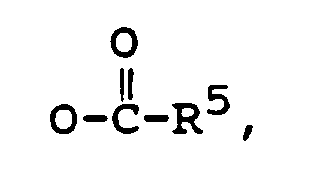
R³ is -CH₃, or -CH₂CH₃,
R⁴ is -H, or C₁₋₄alkyl, and
R⁵ is C₁₋₁₀alkyl,
which comprises oxidizing a compound of the general formula III,

wherein each of R⁶, R⁷ and R⁸ is C₁₋₅ alkyl,
by methods known in the art, and optionally an esterification by methods known in the art.
wherein:
R¹ is -OH, or
R³ is -CH₃, or -CH₂CH₃,
R⁴ is -H, or C₁₋₄alkyl, and
R⁵ is C₁₋₁₀alkyl,
which comprises oxidizing a compound of the general formula III,
wherein each of R⁶, R⁷ and R⁸ is C₁₋₅ alkyl,
by methods known in the art, and optionally an esterification by methods known in the art.
15. The process of Claim 14 to obtain 3β-Hydroxy-10-(2-propynyl)-19-norandrost-5-ene-17-one.
16. A pharmaceutical composition containing 10-(2-propynyl)-19-norandrost-5-ene-3β,17β-diol
or a compound of any of Claims 1 to 6, optionally in combination with a pharmaceutically
acceptable carrier and/or diluent.
17. The pharmaceutical composition according to Claim 16 which comprises additionally
a 3β-hydroxy-steroid dehydrogenase-isomerase and aromatase enzyme and is useful for
inhibiting aromatase activity.
18. A pharmaceutical composition according to Claim 16 for treating hyperestrogenemia.
19. A pharmaceutical composition according to Claim 17 wherein due to the aromatase inhibition
an anti-fertility effect is produced.
20. A pharmaceutical composition according to Claim 16 for treating estrogen-dependent
disease processes.
1. Verbindung der folgenden allgemeinen Formel I,

in der
R¹ eine Gruppe -OH oder

darstellt,
R² eine Gruppe -OH, =O oder

darstellt,
R³ eine -CH₃- oder -CH₂CH₃-Gruppe darstellt,
R⁴ ein Wasserstoffatom oder einen C₁₋₄-Alkylrest darstellt, und
R⁵ einen C₁₋₁₀-Alkylrest darstellt,
mit der Maßgabe, daß 10-(2-Propinyl)-19-norandrost-5-en-3β,17β-diol ausgeschlossen ist.
in der
R¹ eine Gruppe -OH oder
darstellt,
R² eine Gruppe -OH, =O oder
darstellt,
R³ eine -CH₃- oder -CH₂CH₃-Gruppe darstellt,
R⁴ ein Wasserstoffatom oder einen C₁₋₄-Alkylrest darstellt, und
R⁵ einen C₁₋₁₀-Alkylrest darstellt,
mit der Maßgabe, daß 10-(2-Propinyl)-19-norandrost-5-en-3β,17β-diol ausgeschlossen ist.
2. Verbindungen gemäß Anspruch 1, wobei R³ eine -CH₃-Gruppe darstellt.
3. Verbindungen gemäß Anspruch 2, wobei R⁴ ein Wasserstoffatom darstellt.
4. Verbindungen gemäß Anspruch 3, wobei R¹ eine Hydroxylgruppe darstellt.
5. Verbindungen gemäß Anspruch 3, wobei R² eine Hydroxylgruppe darstellt.
6. 3β-Hydroxy-10-(2-propinyl)-19-norandrost-5-en-17-on, eine Verbindung gemäß Anspruch
1.
7. Verwendung von 10-(2-Propinyl)-19-norandrost-5-en-3β,17β-diol oder einer Verbindung
nach einem der Ansprüche 1 bis 6 zur Herstellung eines Arzneimittels.
8. Verwendung gemäß Anspruch 7, wobei das Arzneimittel zusätzlich eine 3β-Hydroxy-Steroiddehydrogenase-Isomerase
und ein Aromataseenzym enthält und geeignet zur Hemmung der Aromataseaktivität ist.
9. Verwendung gemäß Anspruch 7, wobei das Arzneimittel zur Behandlung von Hyperöstrogenemie
geeignet ist.
10. Verwendung gemäß Anspruch 8, wobei das Arzneimittel auch eine fruchtbarkeitshemmende
Wirkung zeigt.
11. Verwendung gemäß Anspruch 7, wobei das Arzneimittel zur Behandlung östrogenabhängiger
Krankheitsprozesse geeignet ist.
12. Verfahren zur Herstellung einer Verbindung der allgemeinen Formel I',

in der
R¹ eine Gruppe -OH oder

darstellt,
R² eine Gruppe -OH oder
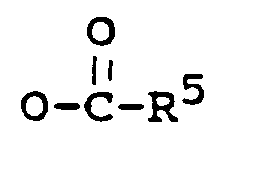
darstellt,
R³ eine -CH₃- oder -CH₂CH₃-Gruppe darstellt,
R⁴ ein Wasserstoffatom oder einen C₁₋₄-Alkylrest darstellt, und
R⁵ einen C₁₋₁₀-Alkylrest darstellt,
umfassend die Umsetzung einer Verbindung der allgemeinen Formel II
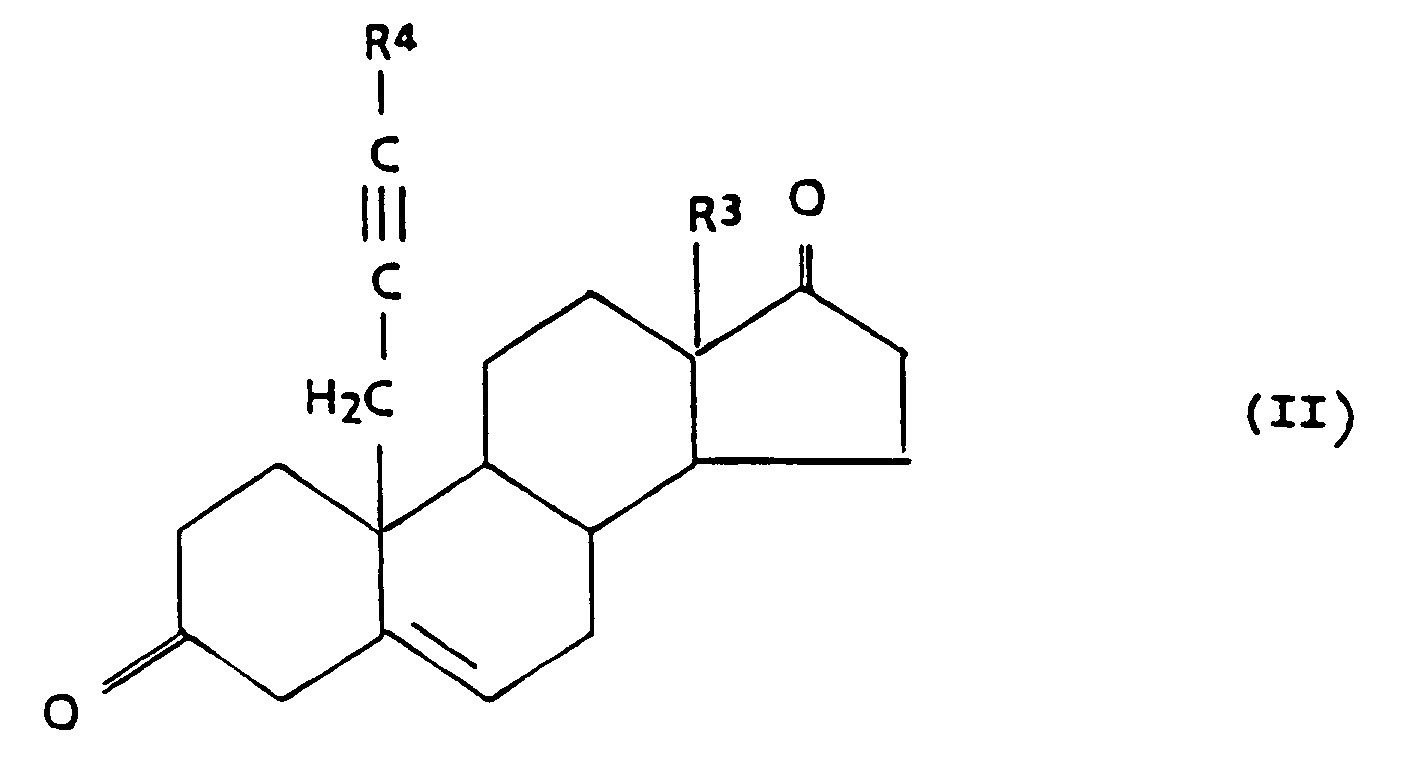
mit Natriumborhydrid, wobei die 3,17-Diolverbindung erhalten wird, und gegebenenfalls eine teilweise oder vollständige Veresterung nach auf dem Fachgebiet bekannten Verfahren.
in der
R¹ eine Gruppe -OH oder
darstellt,
R² eine Gruppe -OH oder
darstellt,
R³ eine -CH₃- oder -CH₂CH₃-Gruppe darstellt,
R⁴ ein Wasserstoffatom oder einen C₁₋₄-Alkylrest darstellt, und
R⁵ einen C₁₋₁₀-Alkylrest darstellt,
umfassend die Umsetzung einer Verbindung der allgemeinen Formel II
mit Natriumborhydrid, wobei die 3,17-Diolverbindung erhalten wird, und gegebenenfalls eine teilweise oder vollständige Veresterung nach auf dem Fachgebiet bekannten Verfahren.
13. Verfahren gemäß Anspruch 12, wobei 10-(2-Propinyl)-19-norandrost-5-en-3β,17β-diol
erhalten wird.
14. Verfahren zur Herstellung einer Verbindung der allgemeinen Formel I'',

in der
R¹ eine Gruppe -OH oder
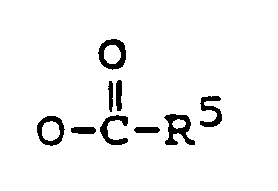
darstellt,
R³ eine -CH₃- oder -CH₂CH₃-Gruppe darstellt,
R⁴ ein Wasserstoffatom oder einen C₁₋₄-Alkylrest darstellt, und
R⁵ einen C₁₋₁₀-Alkylrest darstellt,
umfassend die Oxidation einer Verbindung der allgemeinen Formel III,

in der jeder der Reste R⁶, R⁷ und R⁸ einen C₁₋₅-Alkylrest darstellt,
mit auf dem Fachgebiet bekannten Verfahren und gegebenenfalls Veresterung nach auf dem Fachgebiet bekannten Verfahren.
in der
R¹ eine Gruppe -OH oder
darstellt,
R³ eine -CH₃- oder -CH₂CH₃-Gruppe darstellt,
R⁴ ein Wasserstoffatom oder einen C₁₋₄-Alkylrest darstellt, und
R⁵ einen C₁₋₁₀-Alkylrest darstellt,
umfassend die Oxidation einer Verbindung der allgemeinen Formel III,
in der jeder der Reste R⁶, R⁷ und R⁸ einen C₁₋₅-Alkylrest darstellt,
mit auf dem Fachgebiet bekannten Verfahren und gegebenenfalls Veresterung nach auf dem Fachgebiet bekannten Verfahren.
15. Verfahren gemäß Anspruch 14, wobei 3β-Hydroxy-10-(2-propinyl)-19-norandrost-5-en-17-on
erhalten wird.
16. Arzneimittel, das 10-(2-Propinyl)-19-norandrost-5-en-3β,17β-diol oder einer Verbindung
nach einem der Ansprüche 1 bis 6 enthält, gegebenenfalls in Kombination mit einem
pharmazeutisch verträglichen Träger und/oder Verdünnungsmittel.
17. Arzneimittel gemäß Anspruch 16, wobei es zusätzlich eine 3β-Hydroxy-Steroiddehydrogenase-Isomerase
und ein Aromataseenzym umfaßt und zur Hemmung der Aromataseaktivität geeignet ist.
18. Arzneimittel gemäß Anspruch 16 zur Behandlung von Hyperöstrogenemie.
19. Arzneimittel gemäß Anspruch 17, wobei aufgrund der Aromatasehemmung eine fruchtbarkeitshemmende
Wirkung erzeugt wird.
20. Arzneimittel gemäß Anspruch 16 zur Behandlung östrogenabhängiger Krankheitsprozesse.
1. Composé ayant la formule générale suivante (I),
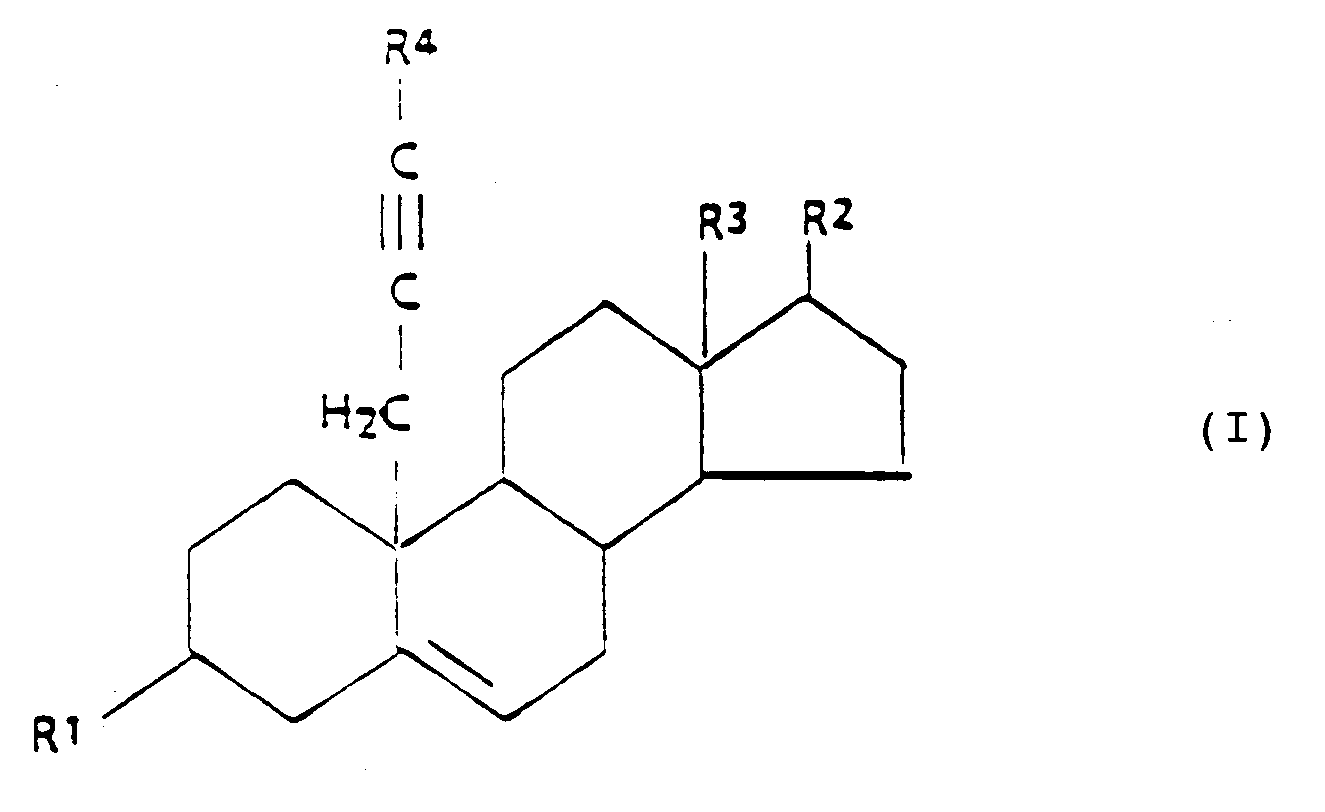
dans laquelle:
R¹ est -OH, ou
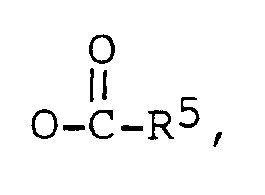
R² est -OH, =O, ou

R³ est -CH₃, ou -CH₂CH₃,
R⁴ est -H, ou un alkyle en C₁-C₄, et
R⁵ est un alkyle en C₁-C₁₀,
à la condition que le 10-(2-propynyl)-19-norandrost-5-ène-3β,17β-diol soit exclu.
dans laquelle:
R¹ est -OH, ou
R² est -OH, =O, ou
R³ est -CH₃, ou -CH₂CH₃,
R⁴ est -H, ou un alkyle en C₁-C₄, et
R⁵ est un alkyle en C₁-C₁₀,
à la condition que le 10-(2-propynyl)-19-norandrost-5-ène-3β,17β-diol soit exclu.
2. Composés selon la revendication 1, dans lesquels R³ est -CH₃.
3. Composés selon la revendication 2, dans lesquels R⁴ est -H.
4. Composés selon la revendication 3, dans lesquels R¹ est -OH.
5. Composés selon la revendication 3, dans lesquels R² est -OH.
6. 3β-hydroxy-10-(2-propynyl)-19-norandrost-5-ène-17-one, composé selon la revendication
1.
7. Utilisation de 10-(2-propynyl)-19-norandrost-5-ène-3β,17β-diol ou d'un composé selon
l'une quelconque des revendications 1 à 6 pour la préparation d'une composition pharmaceutique.
8. Utilisation selon la revendication 7, dans laquelle la composition pharmaceutique
contient de plus une enzyme aromatase et une 3β-hydroxy-stéroïde déshydrogénase-isomérase
et est utile pour l'inhibition de l'activité aromatase.
9. Utilisation selon la revendication 7, dans laquelle la composition pharmaceutique
est utile dans le traitement de l'hyperoestrogénémie.
10. Utilisation selon la revendication 8, dans laquelle la composition pharmaceutique
présente également un effet anti-fertilité.
11. Utilisation selon la revendication 7, dans laquelle la composition pharmaceutique
est utile dans le traitement de troubles oestrogéno-dépendants.
12. Procédé de préparation d'un composé de formule générale (I'),
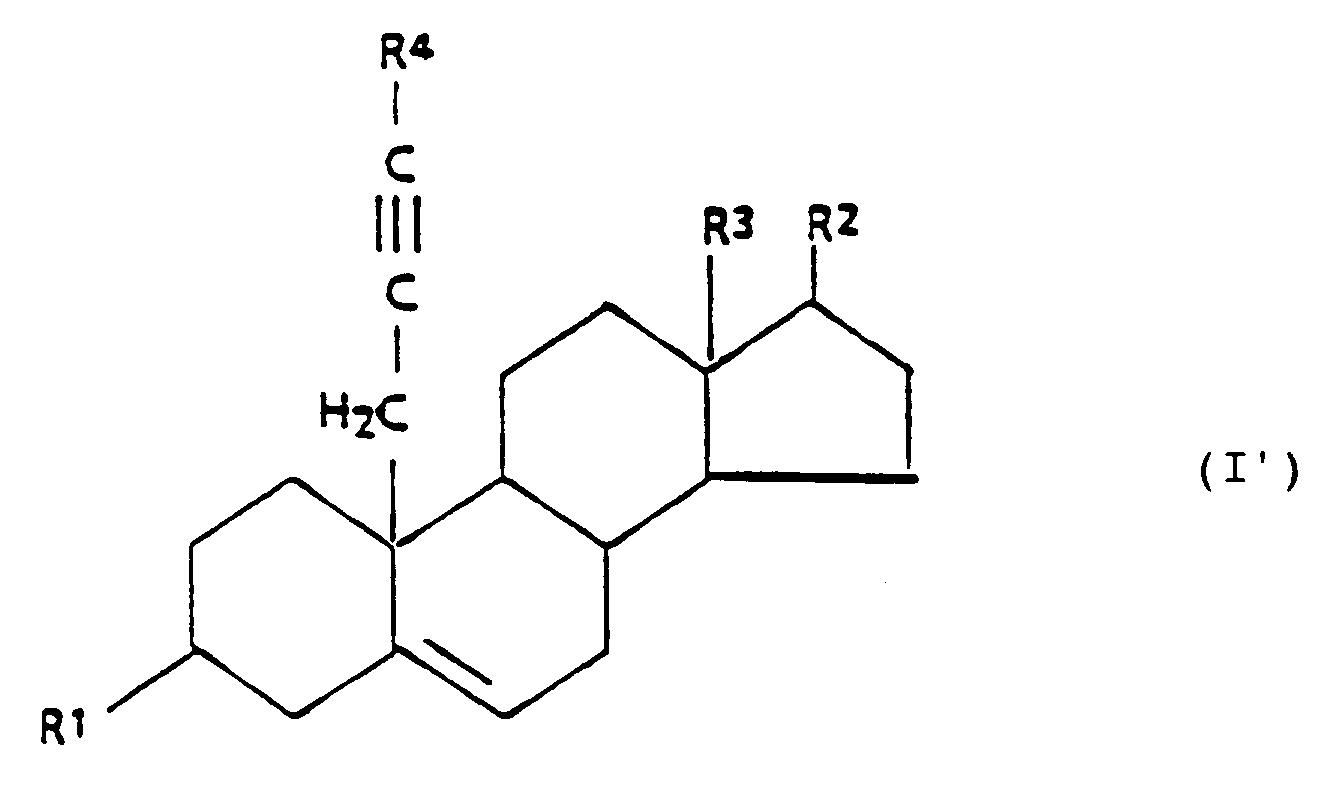
dans laquelle:
R¹ est -OH, ou

R² est -OH, ou

R³ est -CH₃, ou -CH₂CH₃,
R⁴ est -H, ou un alkyle en C₁-C₄, et
R⁵ est un alkyle en C₁-C₁₀,
lequel comprend la réaction d'un composé de formule générale (II),

avec le borohydrure de sodium pour donner le composé 3,17-diol, et éventuellement une estérification partielle ou totale par des méthodes connues dans la technique.
dans laquelle:
R¹ est -OH, ou
R² est -OH, ou
R³ est -CH₃, ou -CH₂CH₃,
R⁴ est -H, ou un alkyle en C₁-C₄, et
R⁵ est un alkyle en C₁-C₁₀,
lequel comprend la réaction d'un composé de formule générale (II),
avec le borohydrure de sodium pour donner le composé 3,17-diol, et éventuellement une estérification partielle ou totale par des méthodes connues dans la technique.
13. Procédé selon la revendication 12, pour obtenir le 10-(2-propynyl)-19-norandrost-5-ène-3β,17β-diol.
14. Procédé de préparation d'un composé de formule générale (I''),

dans laquelle:
R¹ est -OH, ou
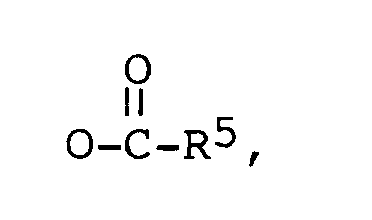
R³ est -CH₃, ou -CH₂CH₃,
R⁴ est -H, ou un alkyle en C₁-C₄, et
R⁵ est un alkyle en C₁-C₁₀,
lequel comprend l'oxydation d'un composé de formule générale (III),

dans laquelle R⁶, R⁷ et R⁸ représentent chacun un alkyle en C₁-C₅, par des méthodes connues dans la technique, et éventuellement une estérification par des méthodes connues dans la technique.
dans laquelle:
R¹ est -OH, ou
R³ est -CH₃, ou -CH₂CH₃,
R⁴ est -H, ou un alkyle en C₁-C₄, et
R⁵ est un alkyle en C₁-C₁₀,
lequel comprend l'oxydation d'un composé de formule générale (III),
dans laquelle R⁶, R⁷ et R⁸ représentent chacun un alkyle en C₁-C₅, par des méthodes connues dans la technique, et éventuellement une estérification par des méthodes connues dans la technique.
15. Procédé selon la revendication 14, pour obtenir la 3β-hydroxy-10-(2-propynyl)-19-norandrost-5-ène-17-one.
16. Composition pharmaceutique contenant le 10-(2-propynyl)-19-norandrost-5-ène-3β,17β-diol
ou un composé selon l'une quelconque des revendications 1 à 6, éventuellement en combinaison
avec un support pharmaceutiquement acceptable et/ou un diluant.
17. Composition pharmaceutique selon la revendication 16, laquelle comprend de plus une
enzyme aromatase et une 3β-hydroxy-stéroïde déshydrogénase-isomérase et est utile
pour l'inhibition de l'activité aromatase.
18. Composition pharmaceutique selon la revendication 16, pour le traitement de l'hyperoestrogénémie.
19. Composition pharmaceutique selon la revendication 17, dans laquelle en raison de l'inhibition
de l'aromatase un effet anti-fertilité est obtenu.
20. Composition pharmaceutique selon la revendication 16, pour le traitement de troubles
oestrogéno-dépendants.
